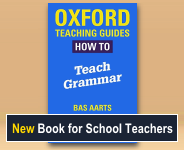Cohesion
Cohesion refers to the grammatical relationships that exist within a text between words, phrases, etc. When we talk only of the semantic links, i.e. the meaning links, we speak of coherence.
Here we focus on cohesion. However, before we do so, consider the following passage:
The sun is shining. Who is your neighbour? I left the washing in the machine. Without doubt she will succeed.
You will agree that this can hardly be called a text. The reason is that the sentences don't link up with each other from the point of view of grammar and meaning. They thus lack cohesion and coherence.
Consider next the following passage from F. Scott Fitzgerald's May Day:
At nine o'clock on the morning of the first of May, 1919, a young man spoke to the room clerk at the Biltmore Hotel, asking if Mr. Philip Dean were registered there, and if so, could he be connected with Mr. Dean's rooms. The inquirer was dressed in a well-cut shabby suit. He was small, slender, and darkly handsome; his eyes were framed above with unusually long eyelashes and below with the blue semicircle of ill health, this latter effect heightened by an unnatural glow which colored his face like a low incessant fever.
In this passage the sentences are grammatically linked with each other in many different ways and for this reason it clearly qualifies as a text. Cohesion is achieved here by using cohesive devices such as determiners and pronouns which are particularly useful in this respect. How does this work?
Notice first of all how the protagonist is introduced to us by the writer using the noun phrase a young man. The Head noun man is preceded here by the indefinite article a which signals that the person that the noun phrase refers to has not yet been introduced into the discourse. Subsequently this same person is referred to by the personal pronoun he. This creates a link with the noun phrase a young man. To achieve variation the protagonist is then referred to as the inquirer, followed again by he, and later the possessive pronoun his is used. The determiners and pronouns thus establish links between the different sentences. Notice that the sentences are also linked by having verbs in the past tense (spoke, were, could, was, etc.).
Another cohesive device used in this short extract are conjunctions such as and, which link clauses, and by adverbs. With regard to the latter, notice how the noun phrase the Biltmore Hotel is subsequently referred to by the adverb there. Cohesion is also created by the phrase the latter effect, which refers back to the blue semicircle of ill health.
A further way of creating cohesion is by the use of ellipsis: leaving out words. This occurs in the sentence His eyes were framed above with unusually long eyelashes and below with the blue semicircle of ill health. The 'full' version of this would be His eyes were framed above with unusually long eyelashes and his eyes were framed below with the blue semicircle of ill health. Repeating the words his eyes were framed would make the writing cumbersome and repetitive, so we leave them out, but the very fact that we know that words have been left out links the deleted words with what went before.
Welcome!

Englicious is totally free for everyone to use!
But in exchange, we ask that you register for an account on our site.
If you’ve already registered, you can log in straight away.
Since this is your first visit today, you can see this page by clicking the button below.

